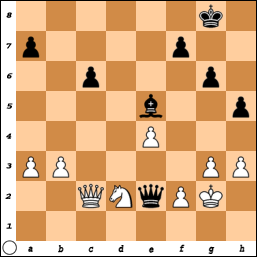Andrew Greet (2425) - Stuart Conquest (2503)
Hippopotamus Defence, 150 Attack
1.d4 g6 2.e4 Bg7 3.Nc3 d6 4.Be3
Greet comments: "I have always enjoyed playing the '150 Attack' against the Pirc and Modern, although I get the feeling that Black should be OK if he plays precisely."
4.Be3 has been played by Kasparov, Anand and many other strong players, and is easily the most popular move in ChessBase's 2019 Mega database.
4...a6 5.Nf3 Nd7
Greet: "I found this to be a slightly annoying move order."
6.Bc4
Greet: "Usually 6.Bd3 would be the preferred square, but after the specific move-order chosen by Black I was slightly concerned about 6...c5!? 7.d5 (otherwise Black gets a fairly comfortable Dragon after ...cxd4 as my bishop would be misplaced on d3) 7...b5 with unclear play."
Most popular is 6.Qd2, which is thematic for the 150 Attack, but the analysis engines Stockfish10 and Komodo9 much prefer Greet's move.
 |
| Greet says "Black must do something about the threat of Bxf7+," but is he right? |
*****
*****
*****
*****
Yes.
6...e6
Out of 87 games in Mega19, 78 feature this move.
The point is that the 'natural-looking' 6...Ngf6? runs into 7.Bxf7+! (the preliminary 7.e5 is also good) Kxf7 8.Ng5+. Now 8...Ke8 and 8...Kf8 lose the queen to 9.Ne6+. That leaves 8...Kg8, but after 9.Ne6+ Qe8 10.Nxc7 Qd8 11.Nxa8, White has a rook and two pawns for a bishop. True, White's a8 knight looks doomed, and Black has the bishop-pair, but White must be much better.
 |
| How should the game proceed? |
*****
*****
*****
*****
Stockfish10 and Komodo9 agree the main line would go 11...b5 12.e5 Bb7!? (12...Ne8 13.Qf3 is even worse, according to the engines, but might be the best practical chance in a game between humans) 13.exf6 Nxf6 14.f3 Qxa8, when White is an exchange and a pawn up.
Going back to the position after 12.e5, I think the best practical chance would be 12...Ne8, but after 13.Qf3 it is far from clear that Black will after all win the knight on a8.
After the game's 6...e6, play continued:
7.a4 b6 8.0-0 Ne7 9.Qd2 h6 10.h3 Bb7 11.Rfe1 Nf6 12.Bf4?!
This may be a mistake as it gives Black a tempo for kingside play. The engines much prefer 12.d5 or 12.Bd3!?
12...g5!
Greet's punctuation.
13.Bh2 g4 14.hxg4 Nxg4 15.Bg3
Four years later the game Anh Dung Nguyen (2500) - Huan Hoang Canh (2378), Vietnamese Championship qualifier, was agreed drawn here, suggesting strong players very much like Black's kingside attacking chances. Stockfish10 reckons the position is dead equal, while Komodo9 prefers White.
15...Ng6 16.Nh2?!
The engines reckon this is a mistake, wanting White to get on with it in the centre or on the queenside.
16...h5 17.Rad1 Kf8!?
This seems to be almost a waiting move. I guess Conquest wanted to get his king off the central files to give himself more flexibility in case of White playing d5 or e5.
18.Qe2 Qg5 19.Nf3 Qe7 20.Nh2!?
This is the engines' choice, but it means Black has developed his queen to e7 without loss of tempo.
20...Nf6 21.Nf1?!
The engines still want White to get on with it in the centre, giving 12.e5 with unclear play.
21...h4
Stockfish10 at first gives Black a winning advantage after this move, but given sufficient time it slowly comes to have Black as just slightly better. Komodo9 also prefers Black, but only by about a fifth of a pawn.
22.Bh2 Bh6?!
Komodo9 prefers Greet's suggestion of 22...h3, when best seems to be the horrible-looking 23.g3, but Stockfish10 reckons Black has time to consolidate his queenside with 22...a5.
The frequent differences in the engines' evaluations highlight how unclear these positions can be (even as I type this, Stockfish10 comes round to liking 22...h3, at one point reckoning it gives Black a winning advantage).
23.Qf3 Nh7
Greet says 23...Kg7 was better. The engines give 23...h3!? or 23...Bg5, but disagree on how much Black is better (if at all).
24.Qh5
Greet is harsh on this, saying he should have played 24.Rd3. The engines are not so sure.
24...Nf6 25.Qf3 Kg7 26.Qh3
Greet calls this "quite a senseless move," but does not give an alternative, and it is Komodo9's second-choice (behind continuing redeployment of the king's knight with 26.Ne3).
26...Rag8!
Neither engine suggests this move, but, once shown it, Stockfish10 comes to very much rate it. I give it an exclamation mark because of the engines' initial indifference, but to me it looks like the type of move many club players would instinctively choose.
27.d5?
"This achieves nothing," says Greet. Perhaps more importantly, it allows Black to seal the centre, which is the normal source of counterplay when an opponent is attacking down a flank.
27...e5 28.Ne3
 |
| How should Black proceed? |
*****
*****
*****
*****
*****
28...Bxe3!
Giving up his bad-but-active bishop in a position that does not seem promising for White's bishop-pair. On top of this, Conquest has seen a tactical point.
29.fxe3?
This loses an exchange (can you see how?) but, as Greet says, 28.Qxe3 Ng4 "would have left Black well and truly in control."
29...Bc8 30.Qf3 Bg4 (0-1, 49 moves)



























